ornate silverware of Pakistan
Ornate Silverware of Pakistan - The Origins of Pakistani Silverware Craft
The ornate silverware of Pakistan reflects a blend of its rich cultural heritage and artisanal craftsmanship, often tied to the regions from which it originates. The intricate designs and motifs etched or engraved on the silver pieces—such as trays, bowls, vases, and cutlery as well as Gulab pash i.e. rose water sprinkling container unique to Pakistan—emulating Mughal aesthetics, with floral patterns, geometric shapes, and nature-inspired themes being common.
Pakistan’s rich cultural heritage is reflected in many of its traditional crafts, with ornate silverware standing out as one of the most treasured of these crafts. The craft of silverware in Pakistan has roots that stretch back centuries, drawing inspiration from the Mughal Empire, Persian influence, and regional artistry. Known for its intricate designs, painstaking craftsmanship, and cultural symbolism, the silverware of Pakistan is not just functional but also an embodiment of the country's rich artistic legacy.
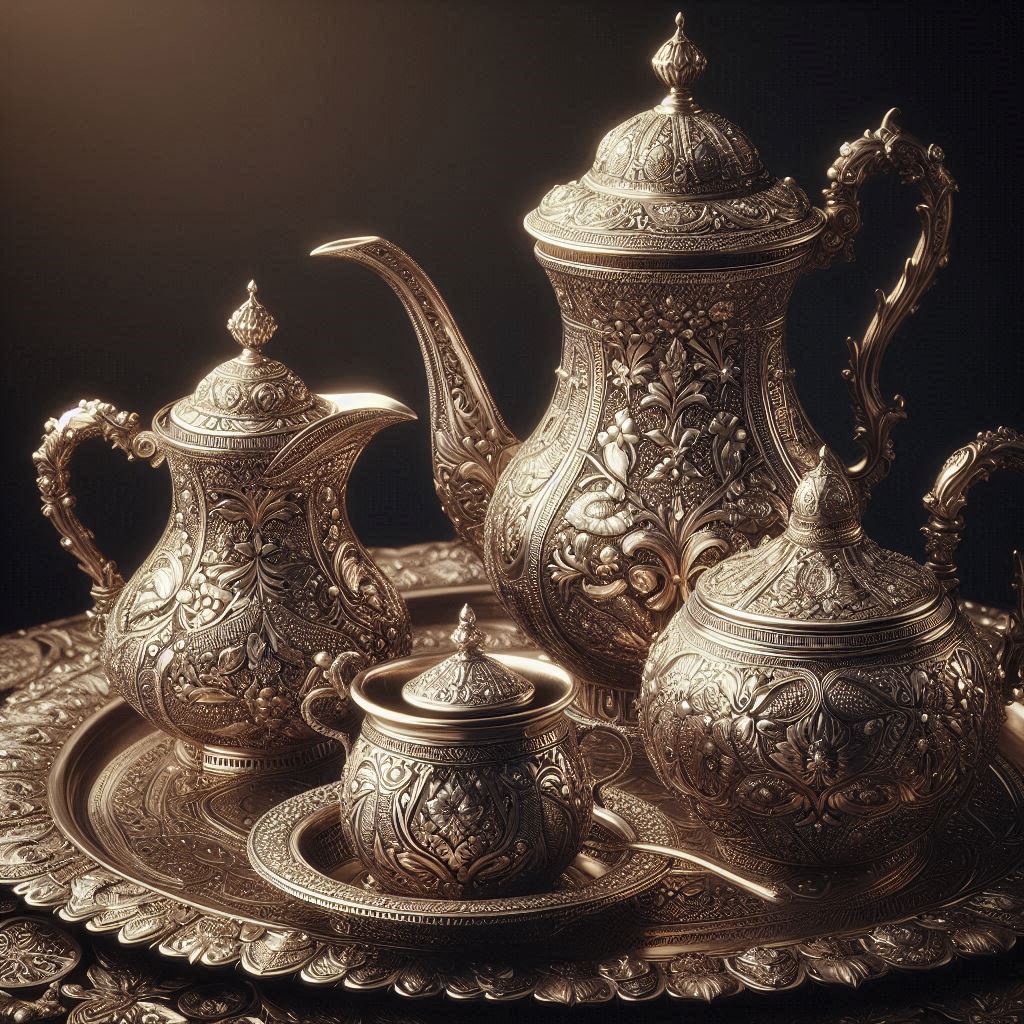 Ornate Silverware Tea Set with Tray
Ornate Silverware Tea Set with TrayOrnate Silverware of Pakistan - A Heritage of Elegance and Craftsmanship
Craftsmen in regions like Lahore, Multan, and Peshawar are known for their expertise in silverwork, carrying forward traditions passed down through generations. The process involves meticulous handcrafting, where artisans use traditional tools to hammer and engrave intricate designs onto pure or alloyed silver.
The tradition of making silver utensils in Pakistan can be traced back to the Mughal era, when silver and gold were highly prized by the nobility and ruling elites. Artisans, often trained through generations of family apprenticeship, developed unique techniques for working with precious metals, particularly silver, to create objects of daily use that were also works of art. The demand for luxurious tableware, decor, and ceremonial items among the royal courts ensured that silver-craft flourished, becoming synonymous with prestige and status.
There's a common misconception that silverware is only for the elite, that it's only for special occasions or for display purposes. But the truth is, silverware is an integral part of Pakistani traditions and customs. From weddings to Eid celebrations, silverware is always at the center of it all.
Another misconception is that silverware is only about gold and diamonds. While those materials are certainly luxurious, Pakistani silverware is so much more than that. It's about the intricate designs, the precision, and the craftsmanship that goes into creating each and every piece. It's about the stories behind each piece, the history, and the cultural significance that is woven into every thread. The artisans who create these masterpieces are not just craftsmen, they're storytellers, and their work is a testament to Pakistan's rich cultural heritage.
Pakistan's silverware boasts floral patterns, geometric designs, calligraphy, and even religious symbols, all intricately engraved or embossed onto the surface of each item.
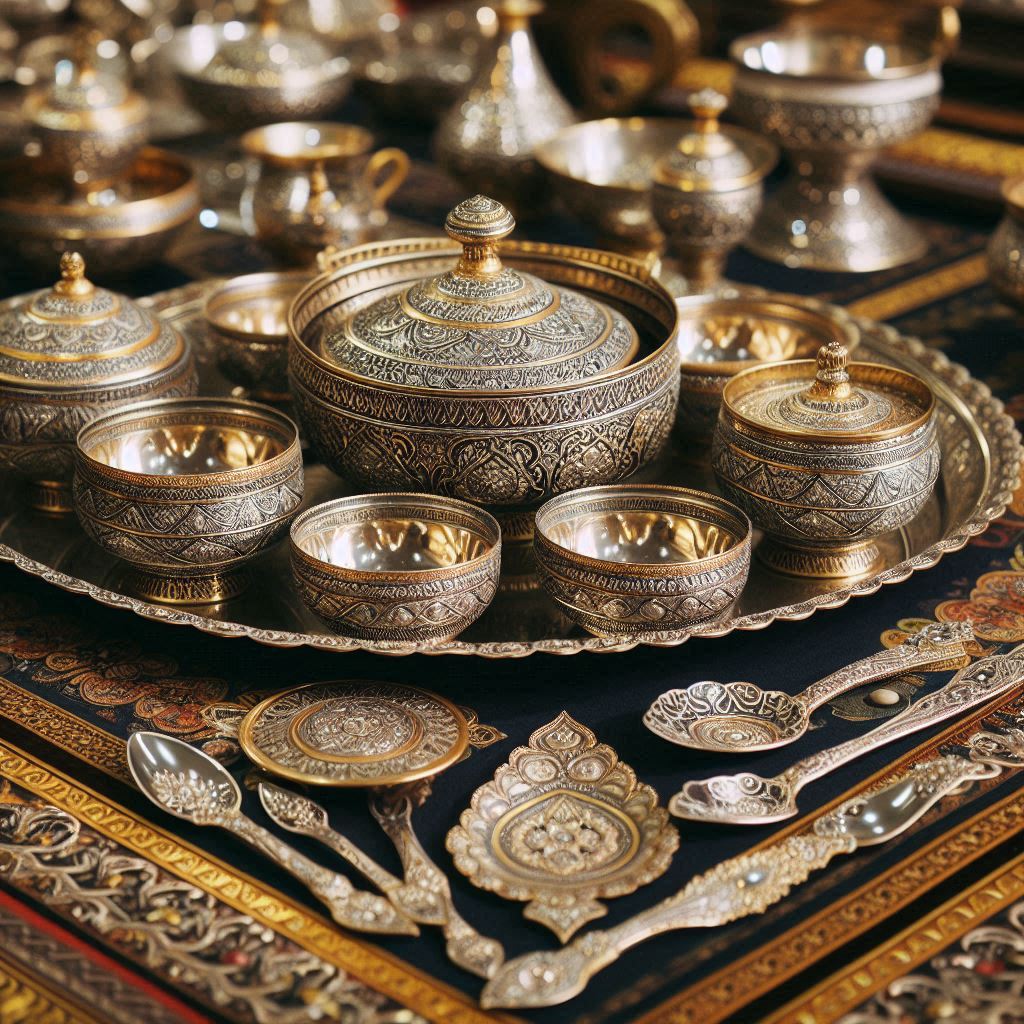 Gold Embellished Silverware
Gold Embellished Silverware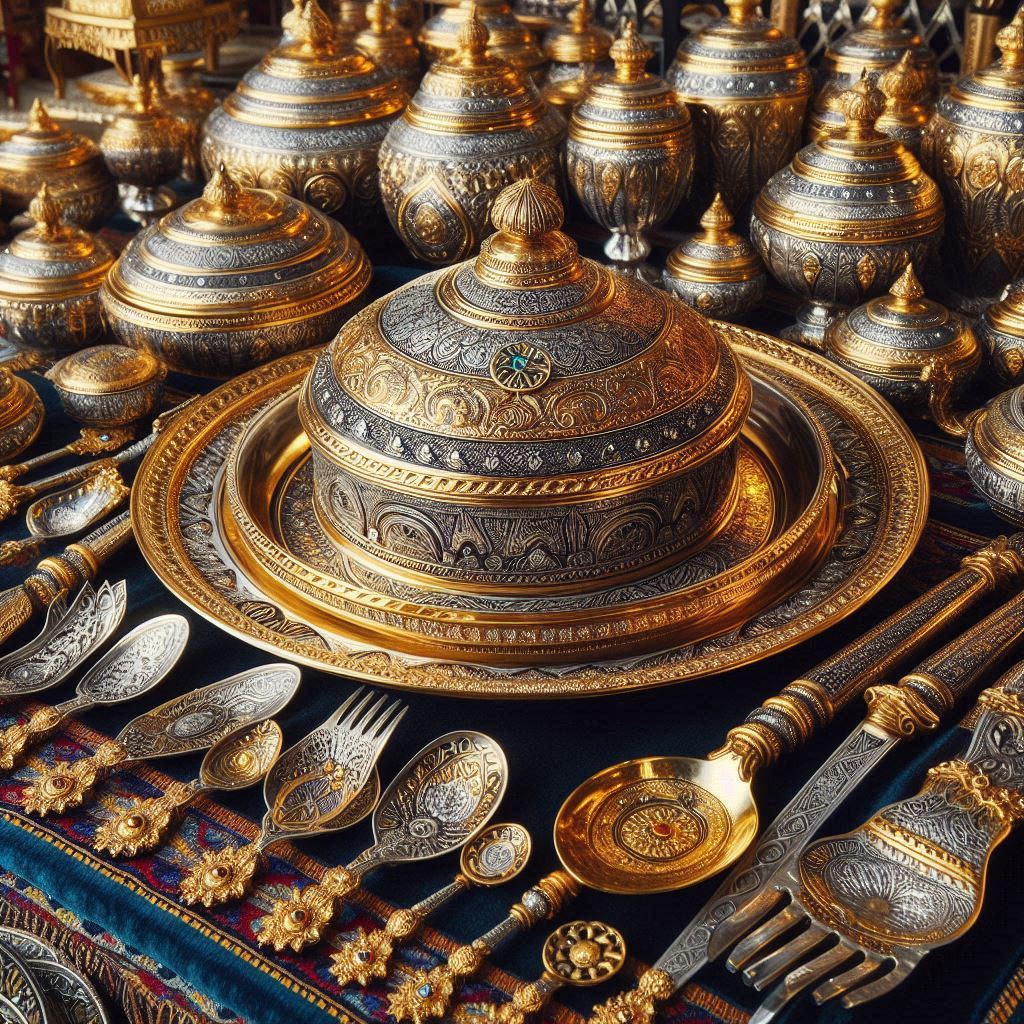 Gold Embellished Silverware
Gold Embellished Silverware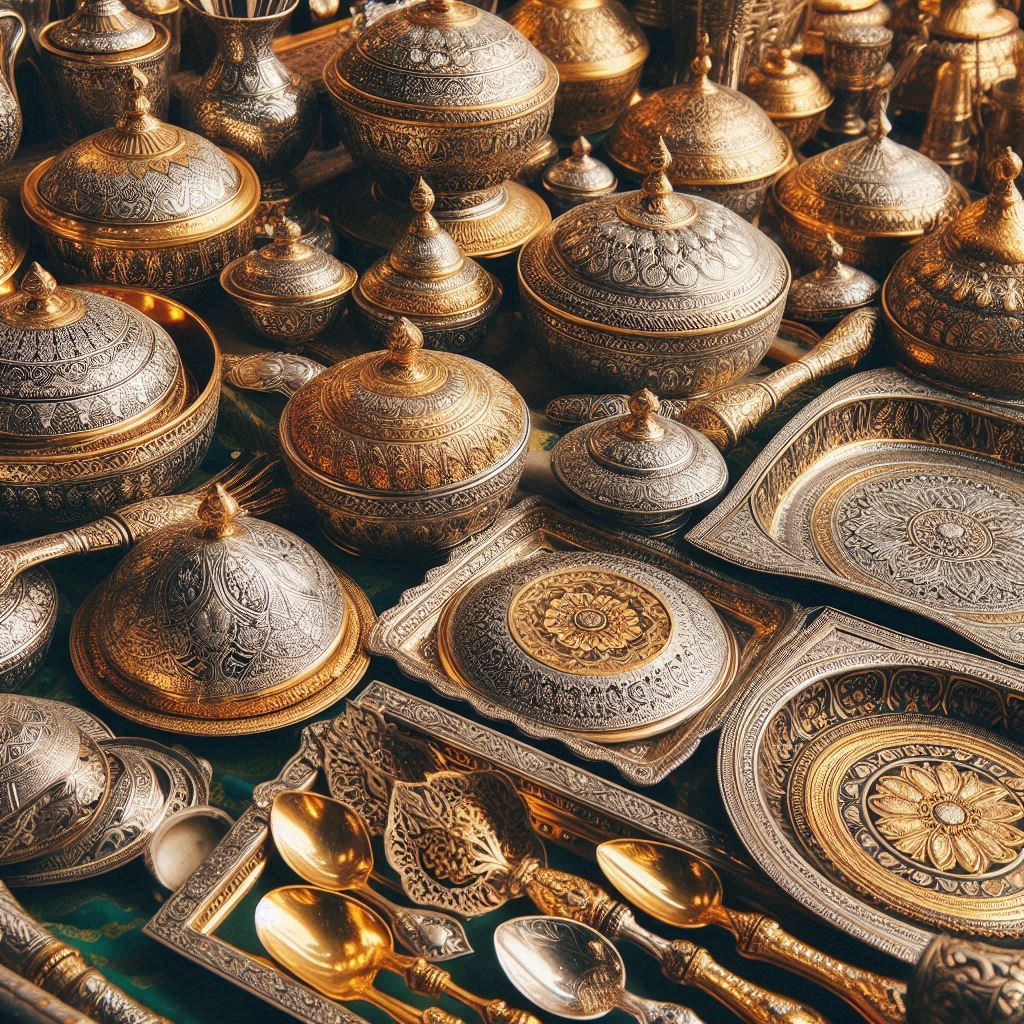 Gold Embellished Silverware
Gold Embellished SilverwareOrnate Silverware of Pakistan - The Craftsmanship Behind the Beauty
Pakistani silverware is a testament to the expertise of the country's artisans, who use age-old techniques to shape, engrave, and decorate the silver. The process often begins with a block of silver, which is melted and then hammered into the desired shape. Intricate designs are then engraved onto the surface using specialized tools. Some pieces are enhanced with repoussé (raised) work, which involves hammering the design from the reverse side to create a three-dimensional effect.
In some cases, artisans use a process called filigree, where fine threads of silver are twisted and soldered to create elaborate lace-like patterns. This technique is especially popular in decorative bowls and tea sets, where the delicate detail adds an air of elegance.
One of the best ornate silverware art pieces are produced by a famous female entrepreneur and designer under the brand name of Taneez. She has kept the beautiful art of ornate high-end silverware alive in Pakistan, despite keeping prices affordable.
Ornate Silverware of Pakistan - Calligraphic Art on Silverware
The tradition of making silver utensils in Pakistan can be traced back to the Mughal era, when silver and gold were highly prized by the nobility and ruling elites. Artisans, often trained through generations of family apprenticeship, developed unique techniques for working with precious metals, particularly silver, to create objects of daily use that were also works of art. The demand for luxurious tableware, decor, and ceremonial items among the royal courts ensured that silver-craft flourished, becoming synonymous with prestige and status.
Pakistan's silverware boasts floral patterns, geometric designs, calligraphy, and even religious symbols, all intricately engraved or embossed onto the surface of each item.
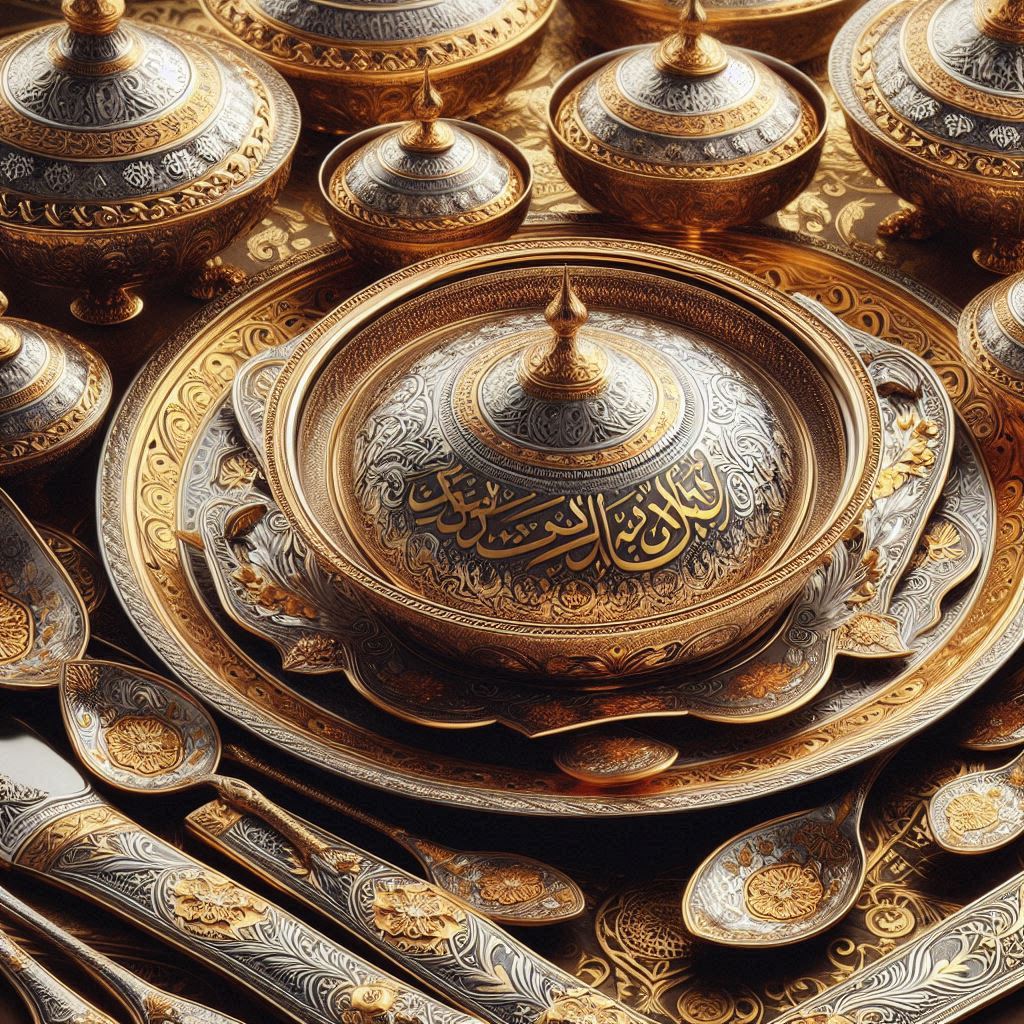 Silverware with Calligraphic Work
Silverware with Calligraphic Work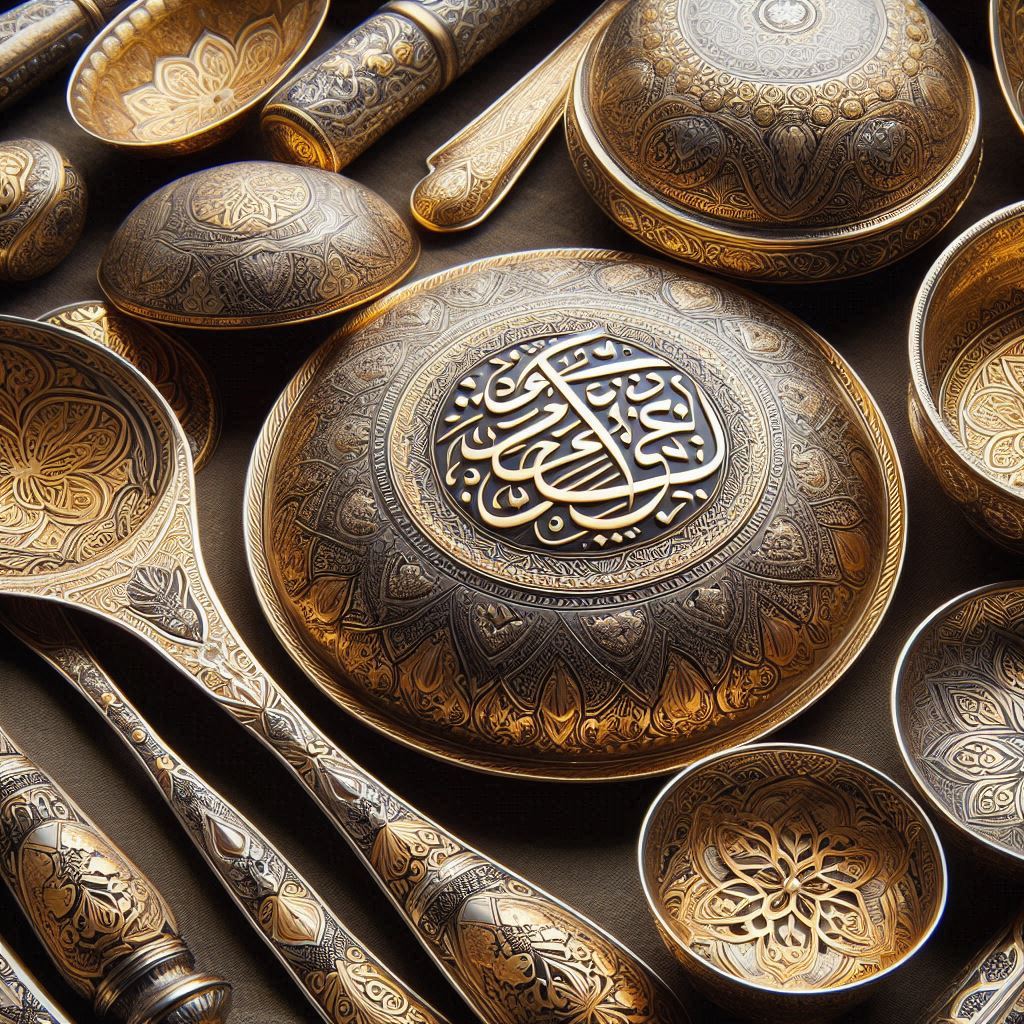 Silverware with Calligraphic Work
Silverware with Calligraphic Work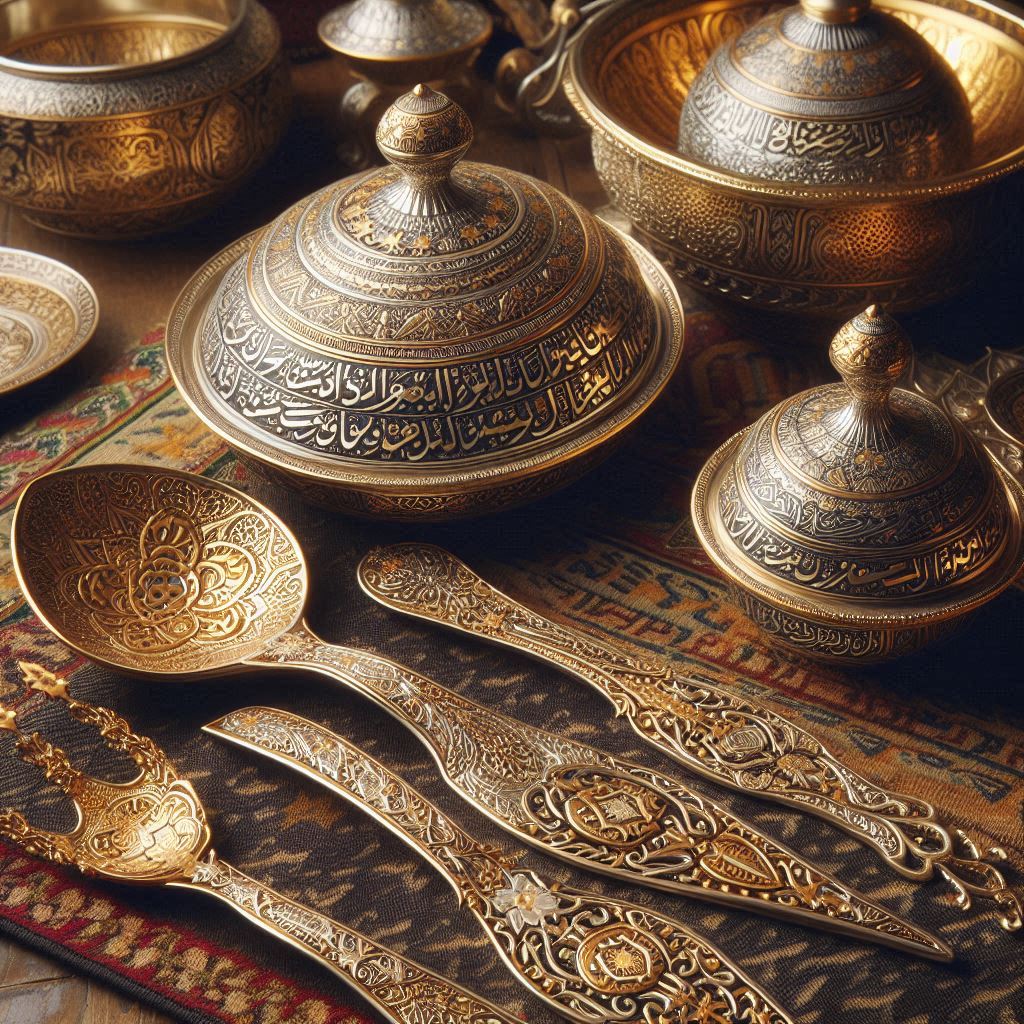 Silverware with Calligraphic Work
Silverware with Calligraphic WorkOrnate Silverware of Pakistan- Types of Ornate Silverware
Pakistani artisans specialize in crafting a wide variety of silver utensils, from everyday household items to elaborate ceremonial pieces. These are made from a range of metals including pure silver, German silver (a silver-colored alloy), and gilt silver (silver plated with gold). The variety of metals used allows for diverse styles and price points, making silverware accessible to different social strata.
Some of the most commonly crafted utensils include:
Trays and Platters (Thalis)
Elaborate silver trays are often used to serve food and drinks during weddings and other special occasions. These trays are typically adorned with floral motifs and fine engravings, often featuring a polished rim and detailed embossing on the surface.
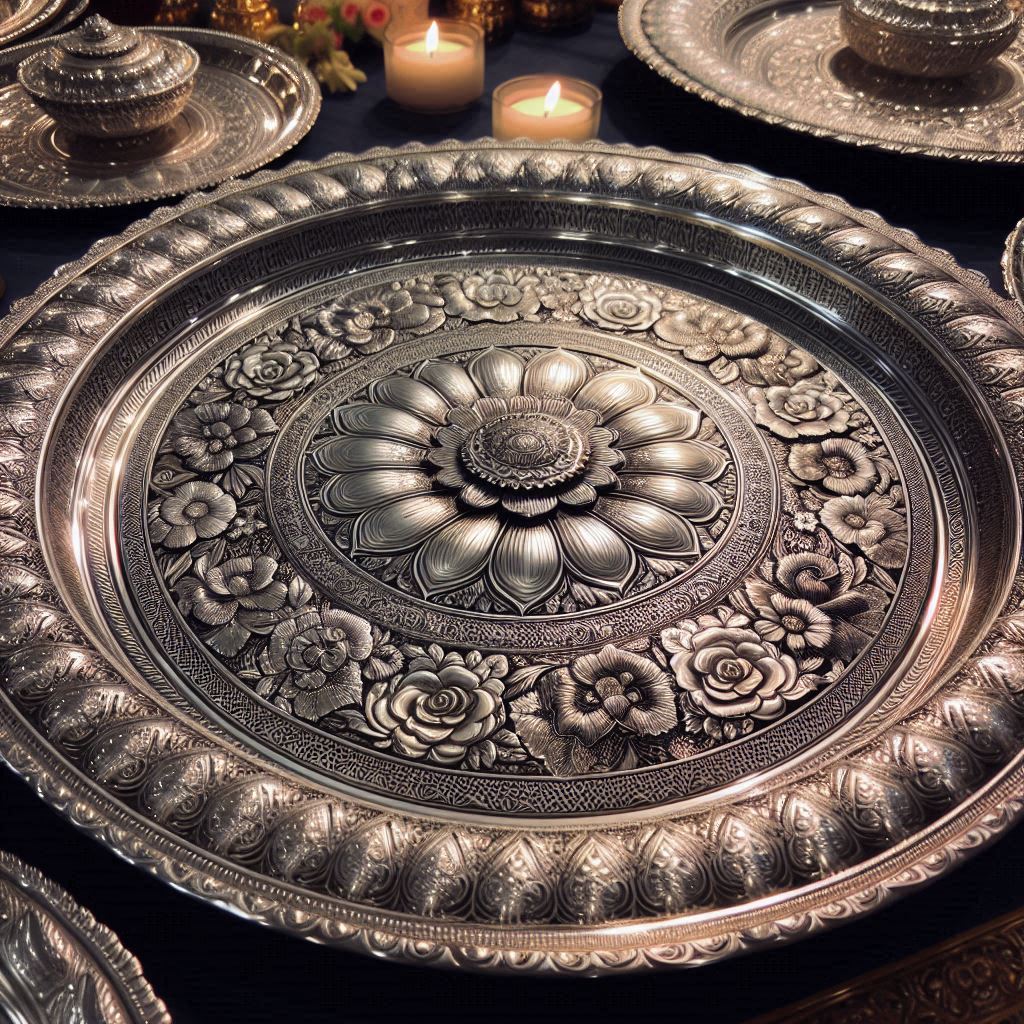 Ornate Silverware Trays
Ornate Silverware Trays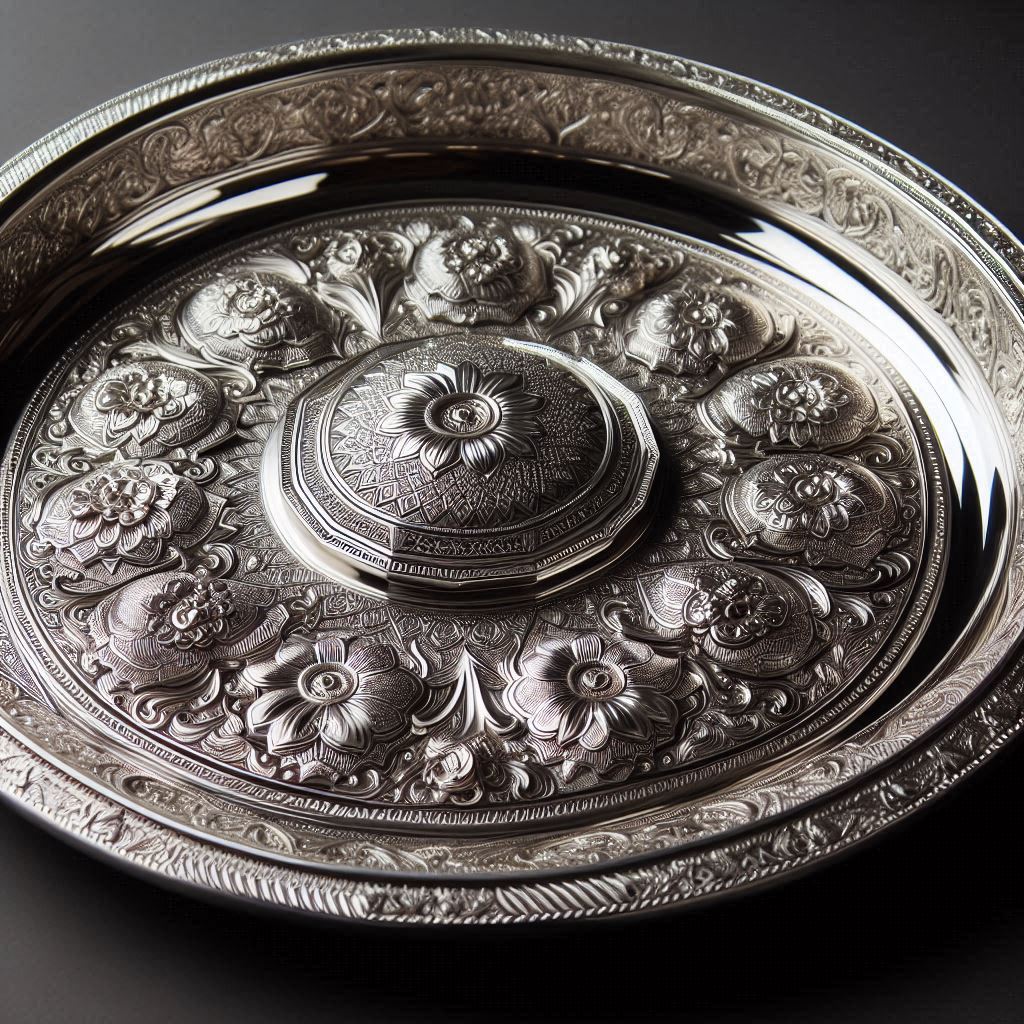 Ornate Silverware Trays
Ornate Silverware Trays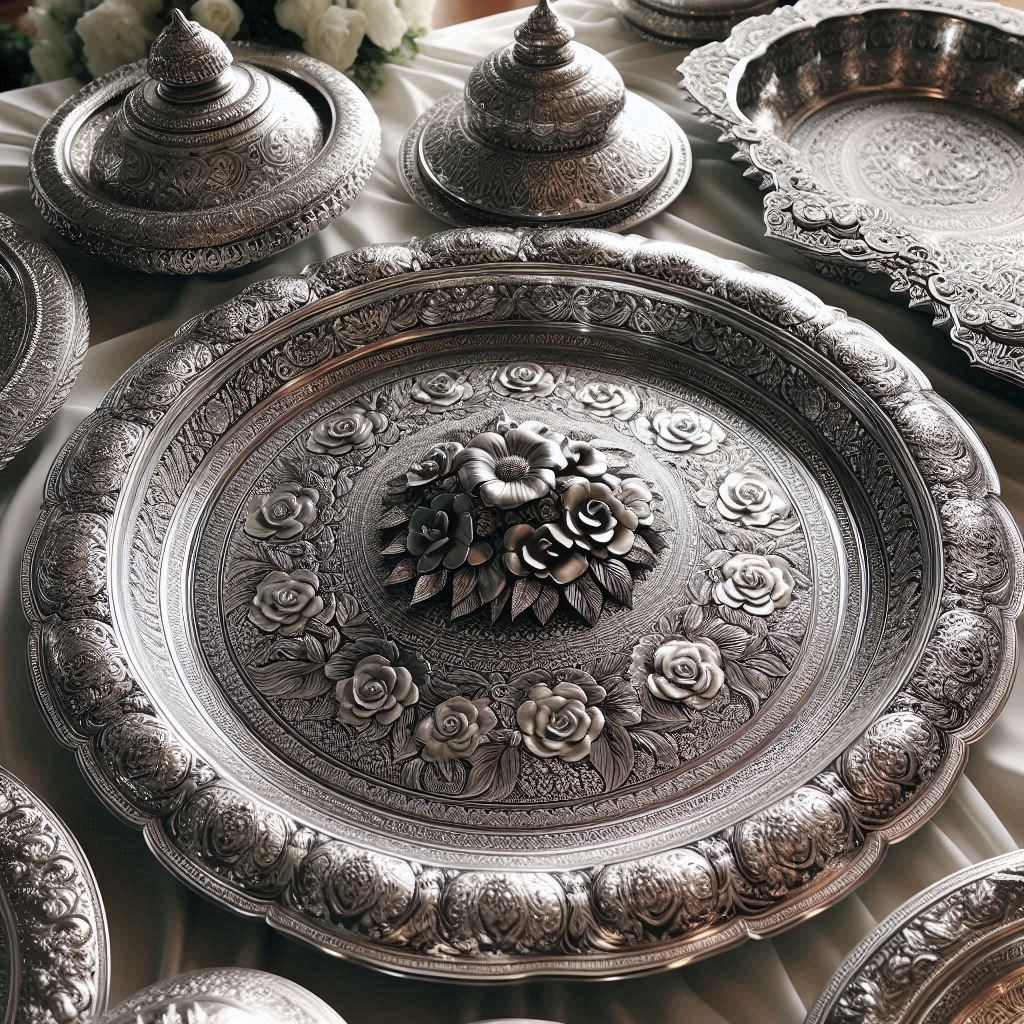 Ornate Silverware Trays
Ornate Silverware TraysDecorative Bowls and Dishes
Decorative bowls and dishes, often used to serve desserts or fruits, are a staple in traditional Pakistani households. Some may be entirely silver, while others feature a combination of silver and gilt silver, adding to their beauty.
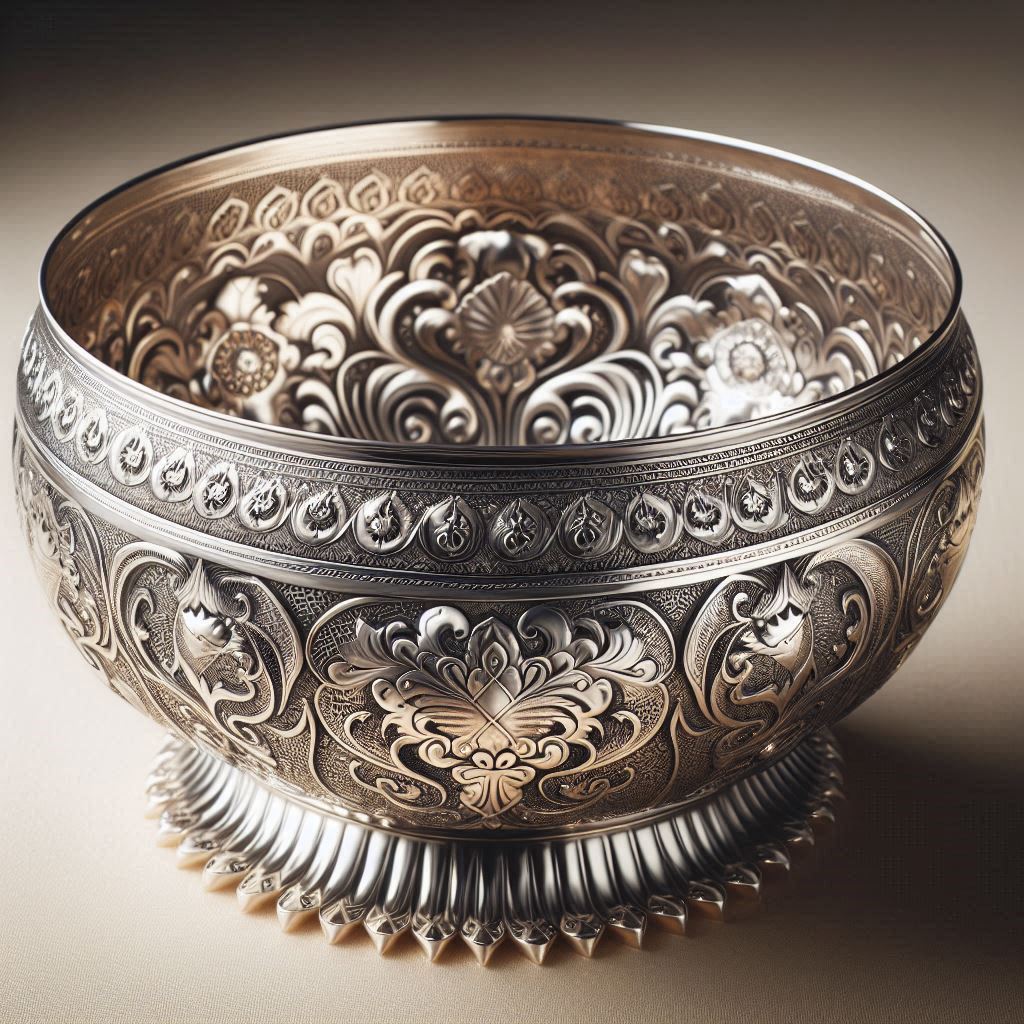 Silverware Bowl
Silverware Bowl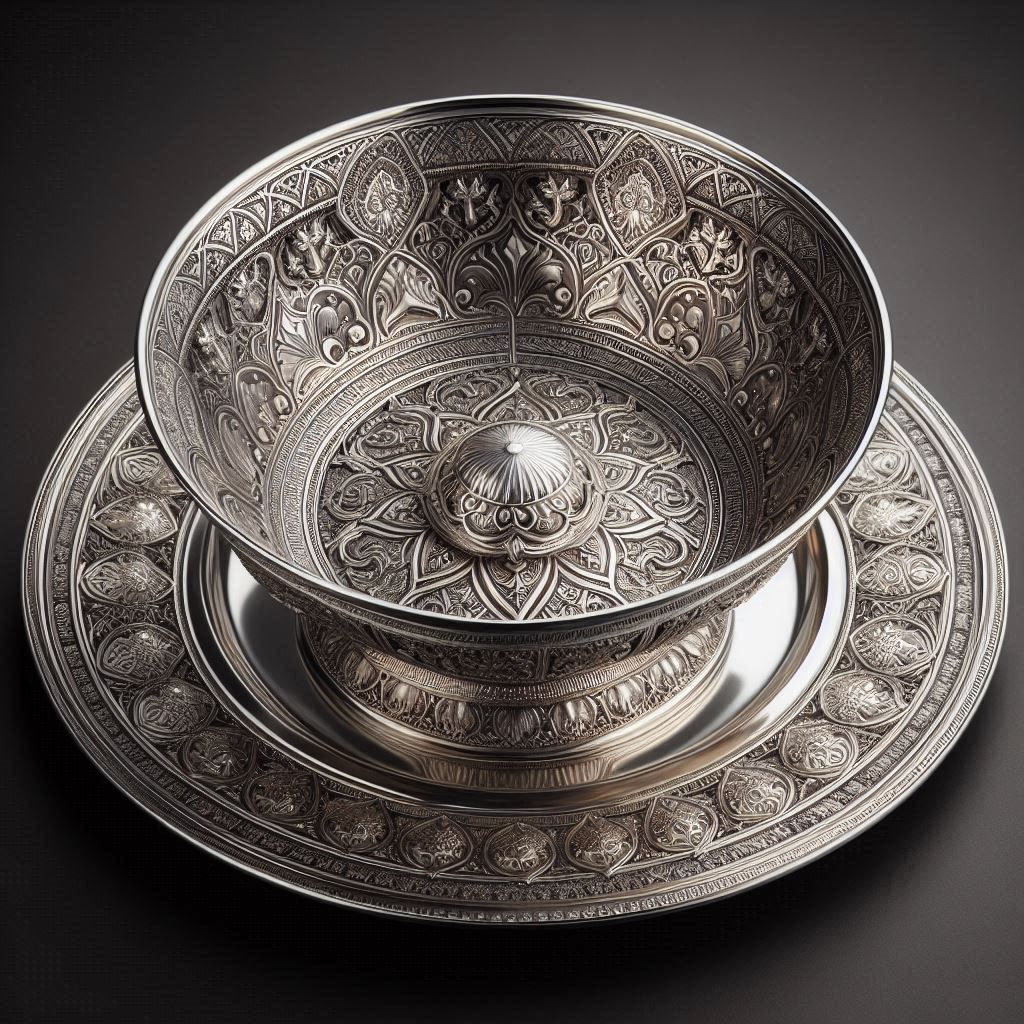 Silver Bowl and Dish
Silver Bowl and Dish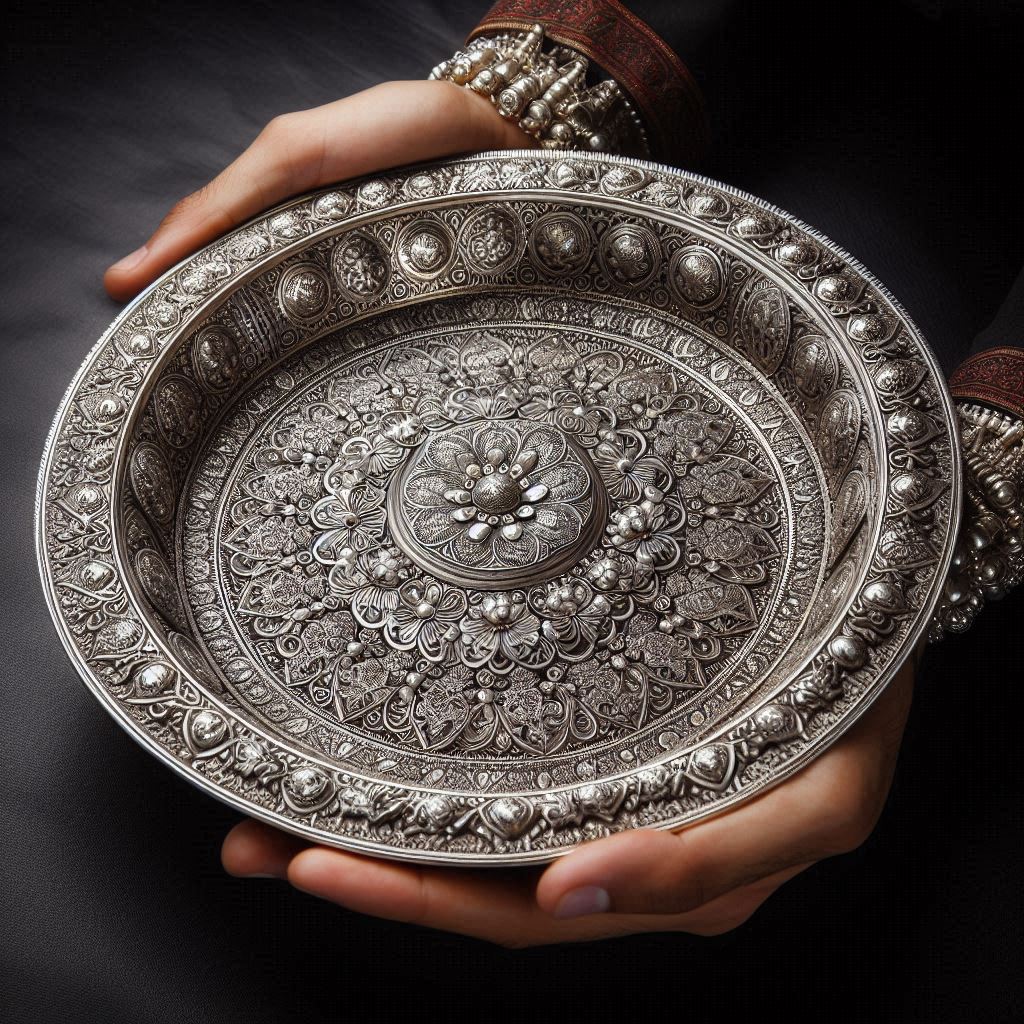 Silverware Decorative Dish
Silverware Decorative DishSilver Tea Sets
Silver tea sets are a symbol of luxury in Pakistan, consisting of intricately designed teapots, sugar bowls, creamers, and cups. These sets often feature motifs of Mughal and floral designs, reflecting the importance of tea culture in Pakistan.
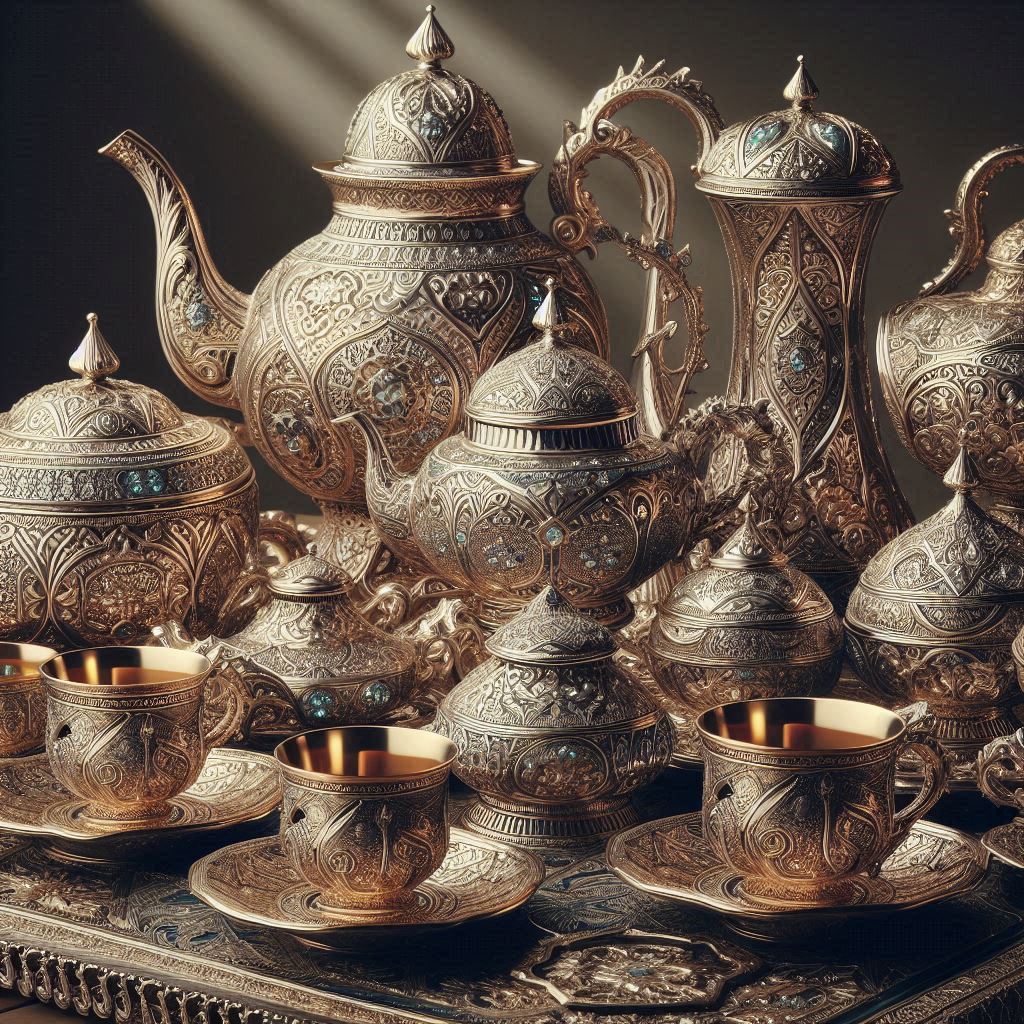 Ornate Silverware Tea Sets
Ornate Silverware Tea Sets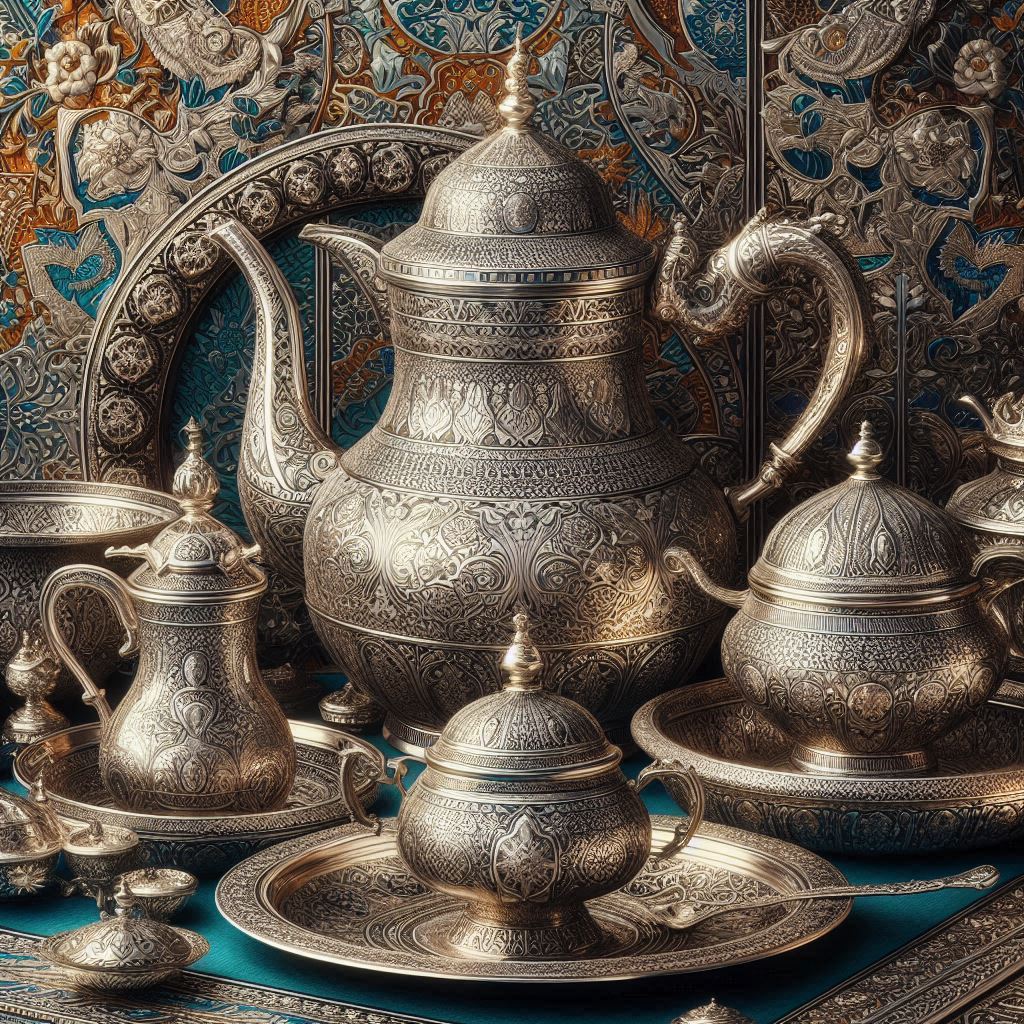 Ornate Silverware Tea Sets
Ornate Silverware Tea Sets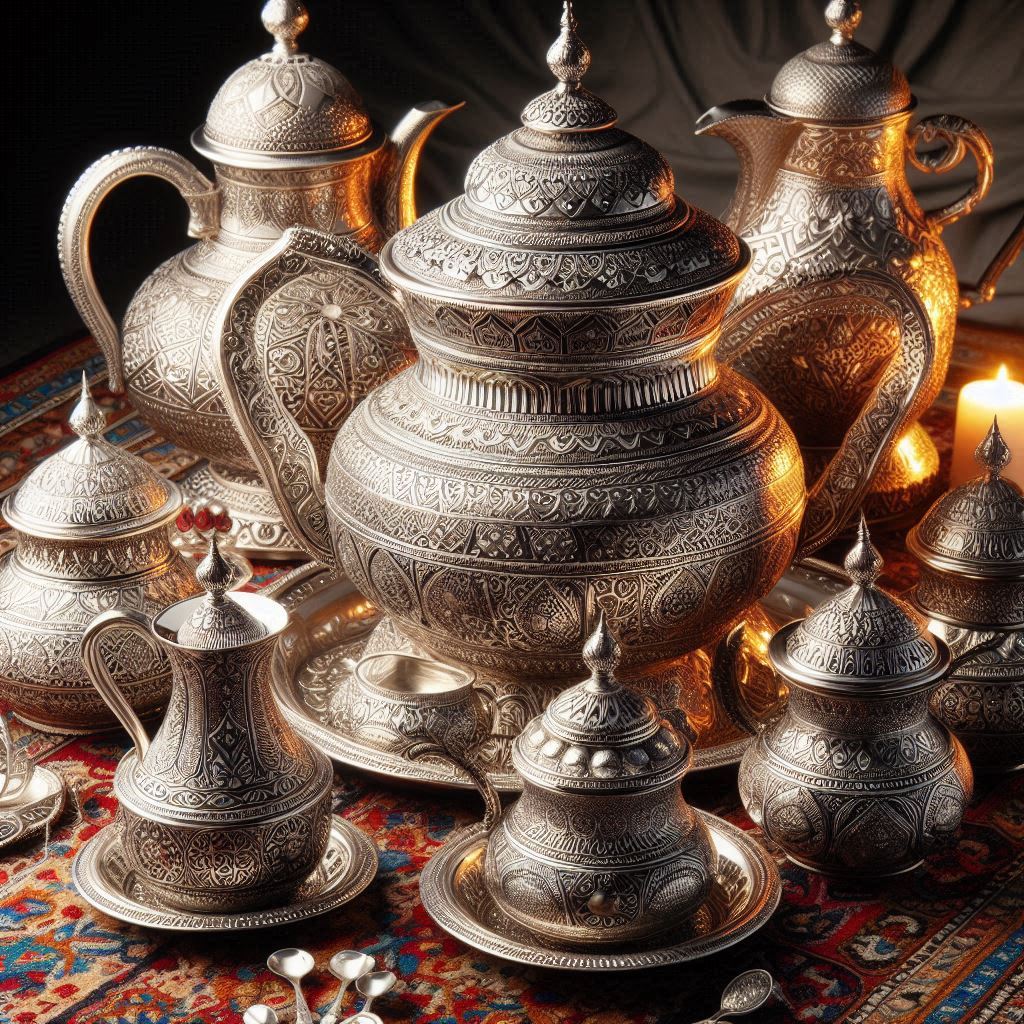 Ornate Silverware Tea Sets
Ornate Silverware Tea SetsGoblets and Tumblers
These drinking vessels are often hand-engraved with intricate designs and make stunning pieces for special events. They may be made from pure silver or a combination of silver and gold, giving them a distinguished aesthetic.
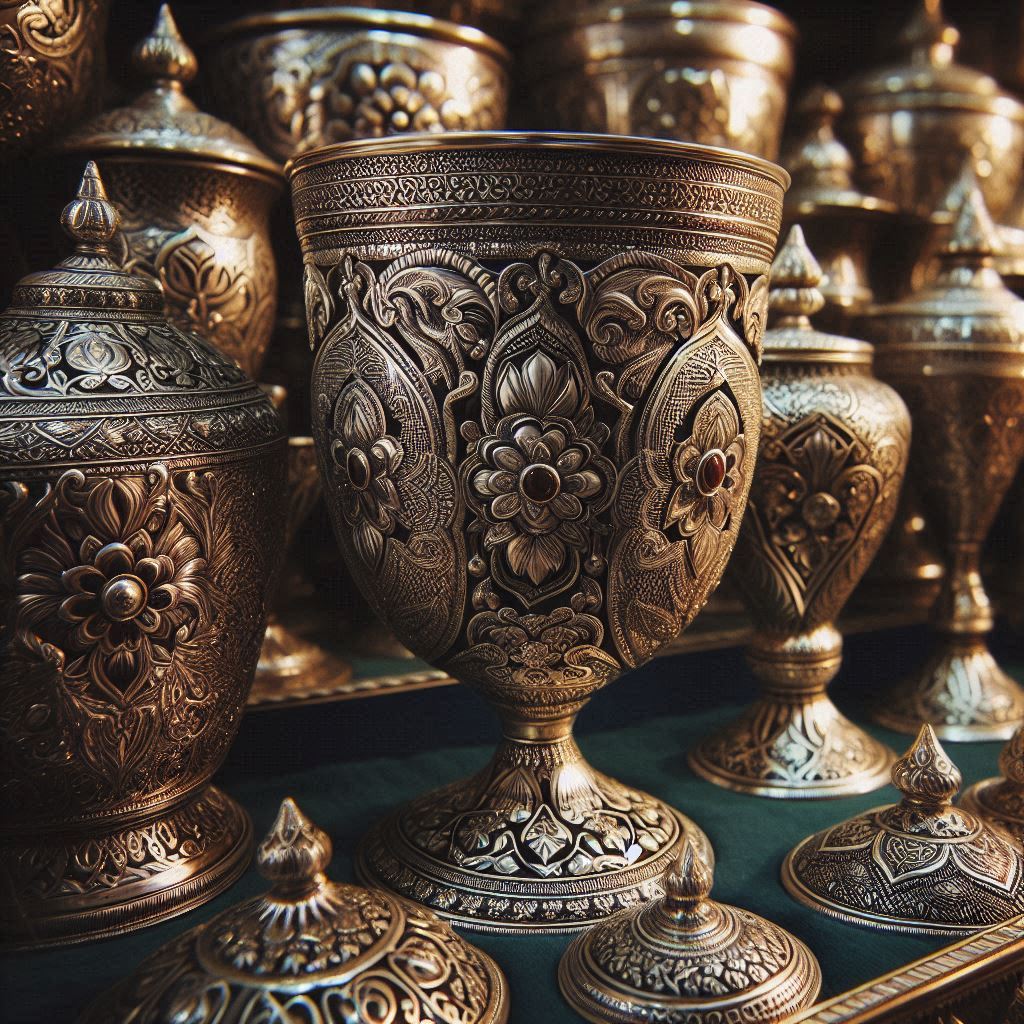 Ornate Silverware Goblet
Ornate Silverware Goblet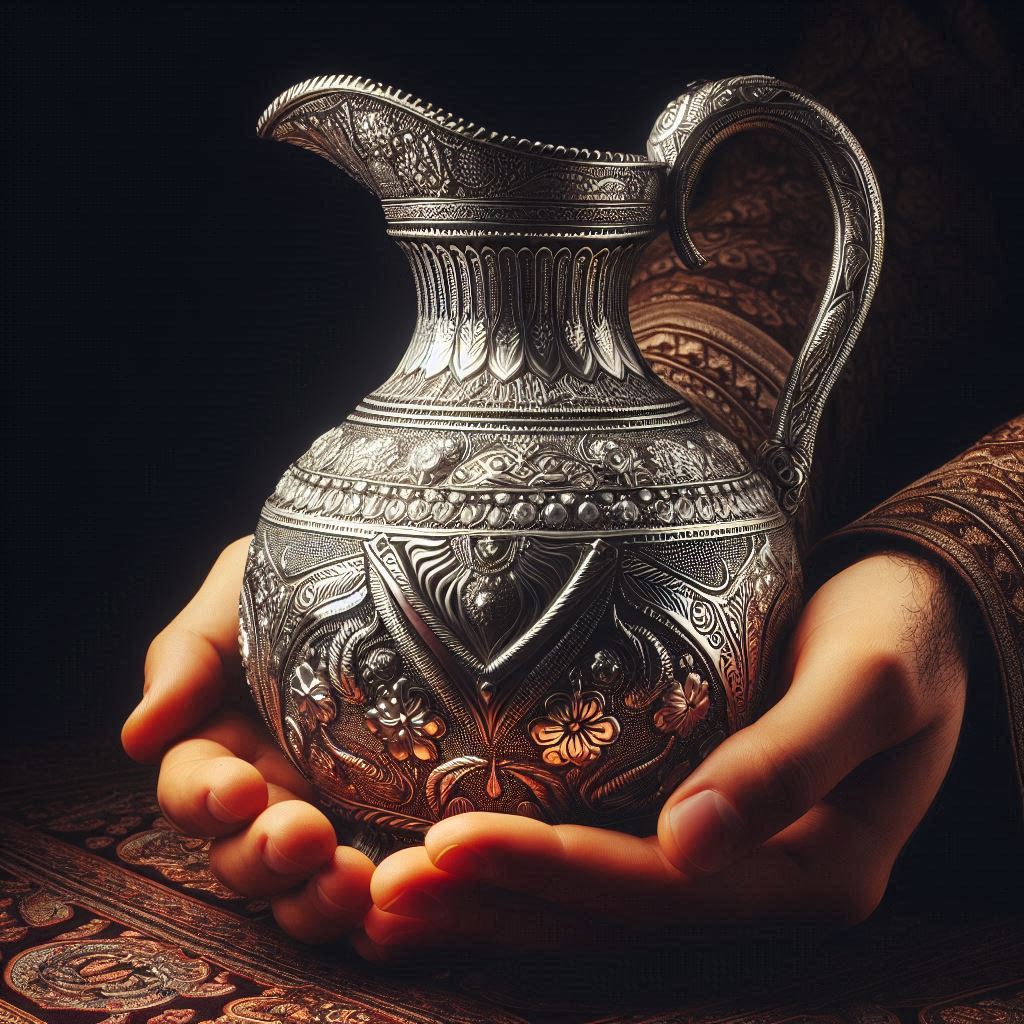 Ornate Silverware Tumbler
Ornate Silverware Tumbler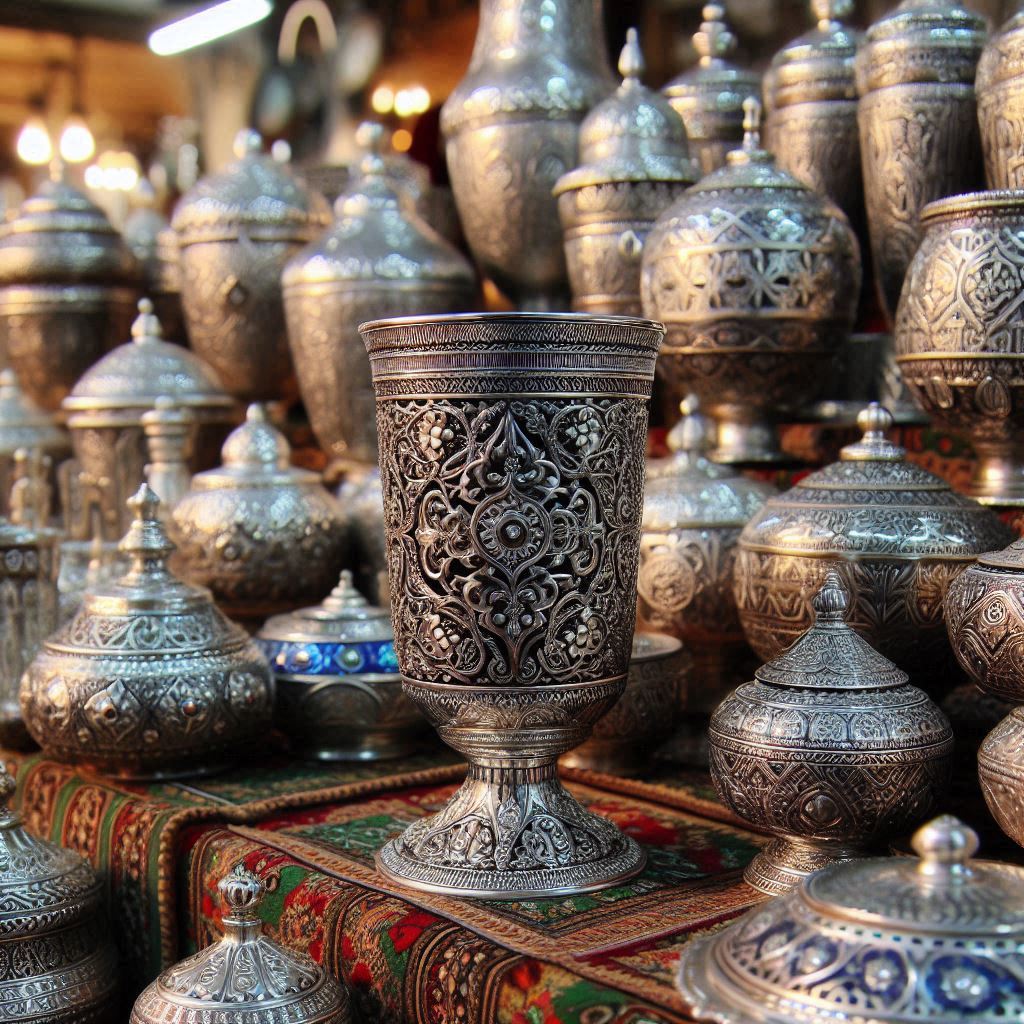 Ornate Silverware Tumbler
Ornate Silverware TumblerCutlery and Serving Utensils
Ornate silver spoons, forks, and knives are made not just for functional use but as artistic pieces that are often reserved for ceremonial dinners or festive occasions. Serving utensils such as ladles and tongs are also common and usually embellished with detailed designs along their handles.
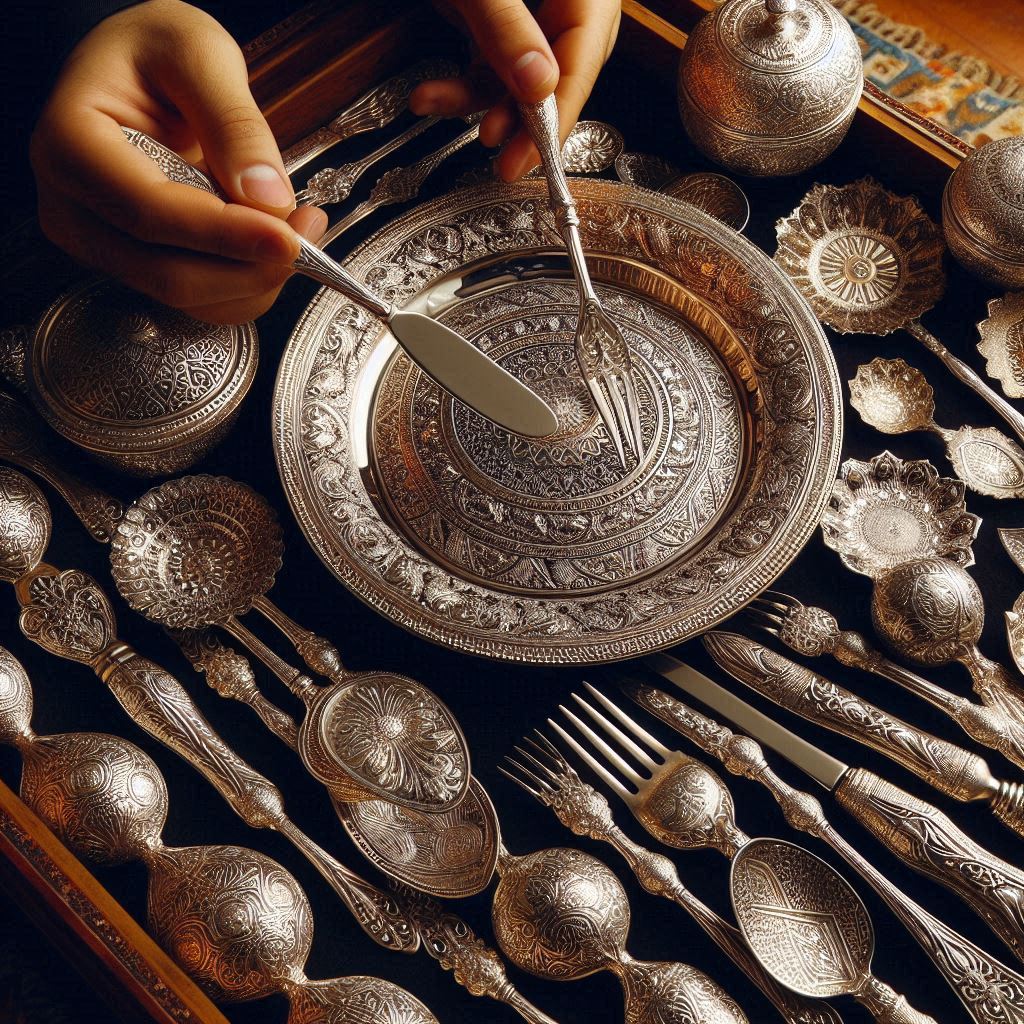 Ornate Silverware Utensils
Ornate Silverware Utensils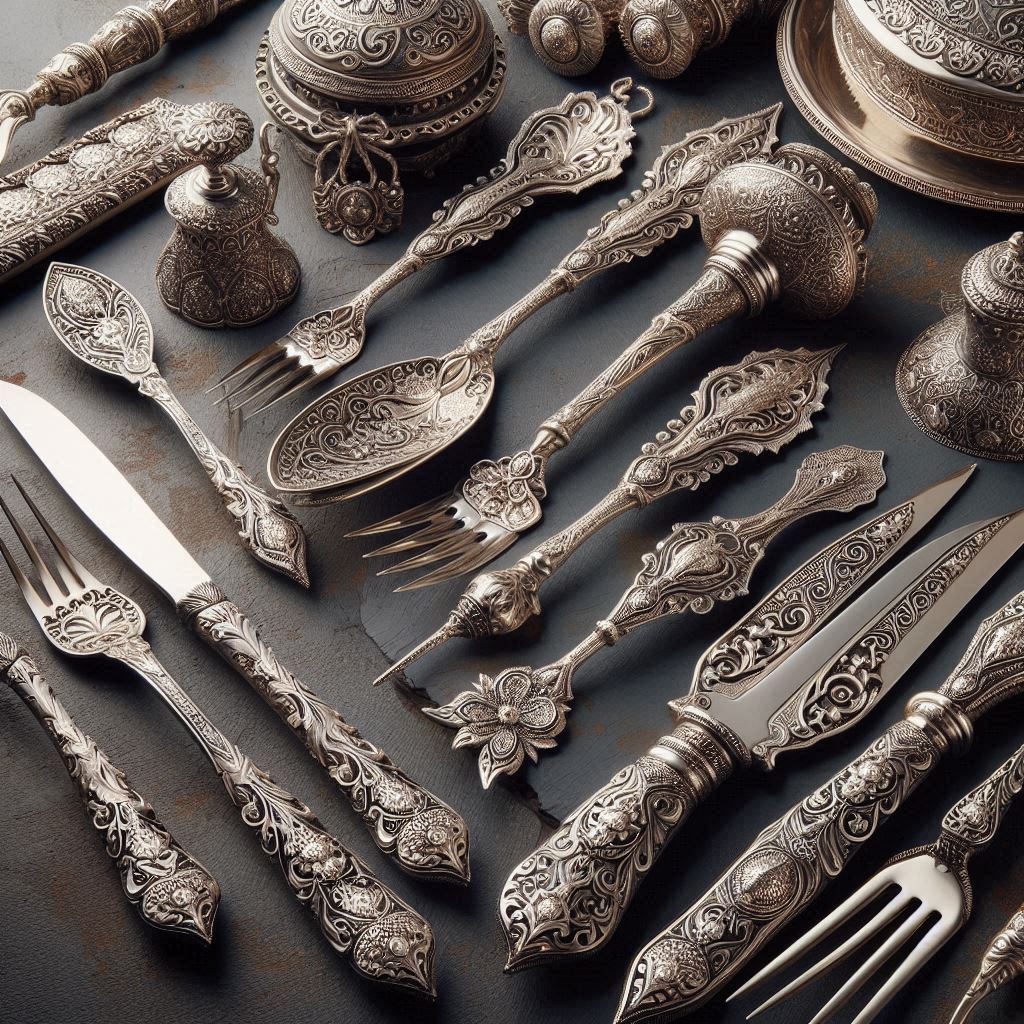 Ornate Silverware Cutlery
Ornate Silverware Cutlery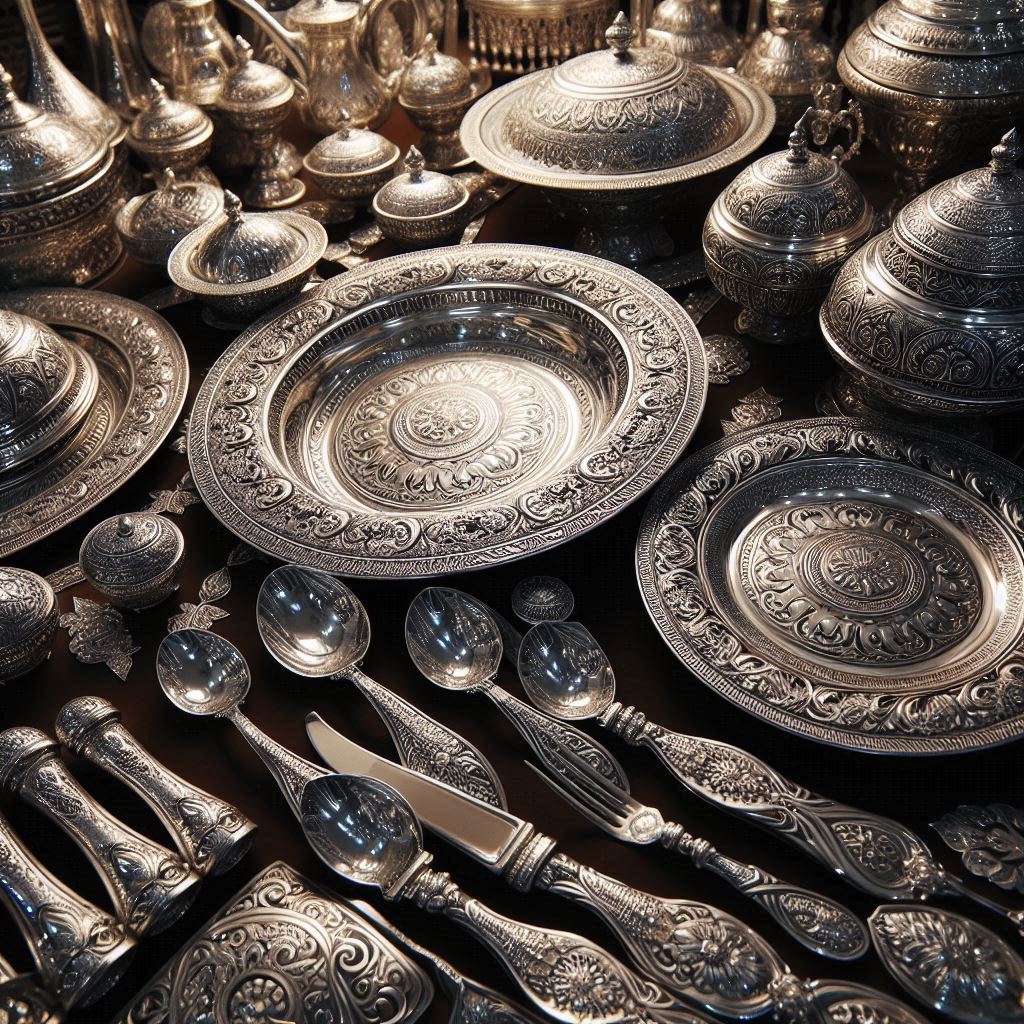 Ornate Silverware Utensils
Ornate Silverware UtensilsOrnate Silverware of Pakistan - Antique Silverware
Antique silverware of Pakistan holds a special place in the country’s cultural heritage, reflecting centuries of skilled craftsmanship and artistic traditions. These exquisite pieces, often passed down through generations, feature intricate engravings, floral patterns, and motifs inspired by Mughal, Persian, and regional influences. From elegant trays and tea sets to delicately crafted cutlery, ceremonial utensils and decorative items, antique silverware is a testament to the artistry of Pakistan’s silversmiths. Each piece is not only a functional object but also a work of art, representing the opulence and history of a bygone era.
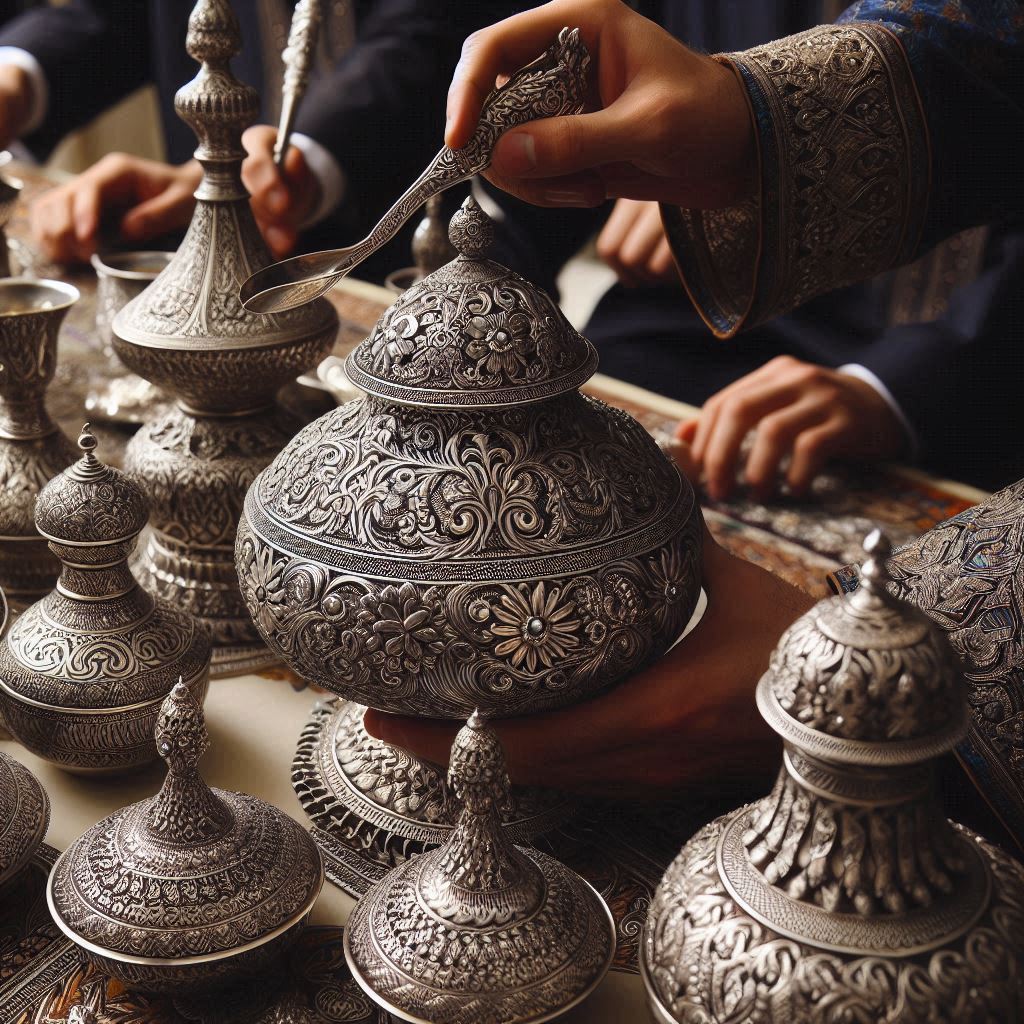 Antique Ornate Silverware
Antique Ornate Silverware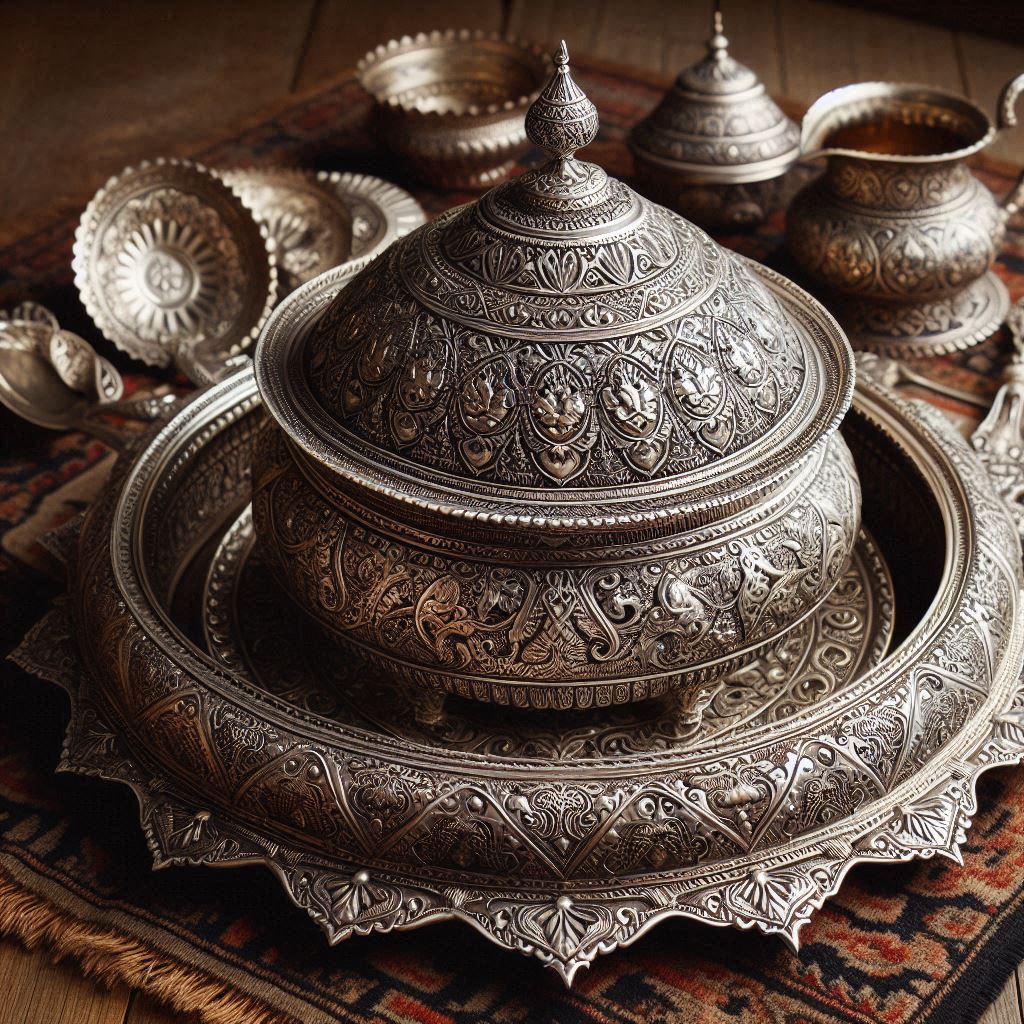 Antique Ornate Silverware
Antique Ornate Silverware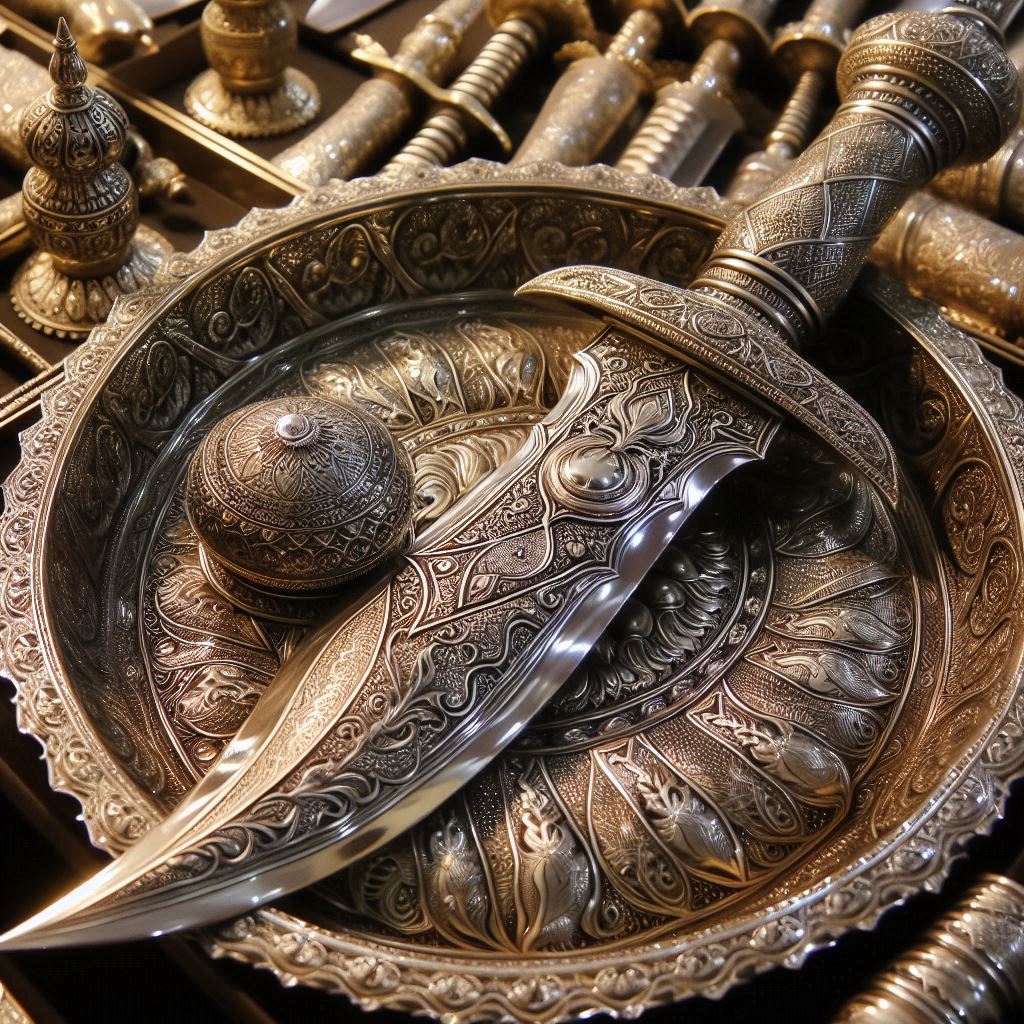 Antique Ornate Decorative Silverware
Antique Ornate Decorative SilverwareOrnate Silverware of Pakistan - German Silver and Gilt Silver in Pakistani Craft
Though pure silver remains the most prestigious material for silverware, Pakistani artisans also work with German silver, an alloy made from copper, zinc, and nickel, which mimics the look of silver. German silver is durable and less expensive, making it popular for decorative items and more affordable utensils. This material is often used for cutlery sets, bowls, and platters that retain an elegant appearance without the cost of pure silver.
Gilt silver, where silver is plated with a layer of gold, is another luxurious material used in Pakistani silverware. Items made from gilt silver were traditionally reserved for royal or elite households, but they continue to be highly valued for their visual appeal and craftsmanship. Gilt silver trays, tea sets, and ceremonial goblets are among the most prized pieces in Pakistani homes.
Ornate Silverware of Pakistan - Symbolism and Cultural Significance
Pakistani silverware is not only admired for its beauty and craftsmanship but also for the cultural significance it holds. Silver utensils are often gifted during weddings, symbolizing wealth, prosperity, and good fortune. These heirlooms are passed down through generations, embodying family history and tradition. Silverware is also a common feature in religious and cultural ceremonies, where it plays a key role in rituals involving food and hospitality.
In rural areas, silver spoons, bowls, and platters are still considered valuable possessions, often displayed with pride during special occasions such as Eid, weddings, or other major celebrations. The continued use of traditional silverware in modern Pakistan reflects the nation's connection to its heritage, even as contemporary designs are incorporated into the craft.
However, with the rise of modern trends and mass-produced items, traditional artisans are facing a significant challenge in keeping their craft alive. The art of silverware making is not just about creating beautiful pieces, it's about preserving a cultural heritage.
As we showcase the most luxurious silverware pieces in Pakistan, we're not just showcasing the grandeur and opulence, we're also celebrating the artisans, the craftsmanship, and the cultural heritage that goes into creating these masterpieces. It's a reminder that Pakistani silverware is not just about luxury, it's about tradition, it's about culture, and it's about preserving a part of our history.
Silverware is not just a luxury item, it's a symbol of our cultural heritage, and it's up to us to preserve it, to celebrate it, and to pass it on to the next generation.
- Home
- Pakistani Home Decor
- Ornate Silveware of Pakistan


